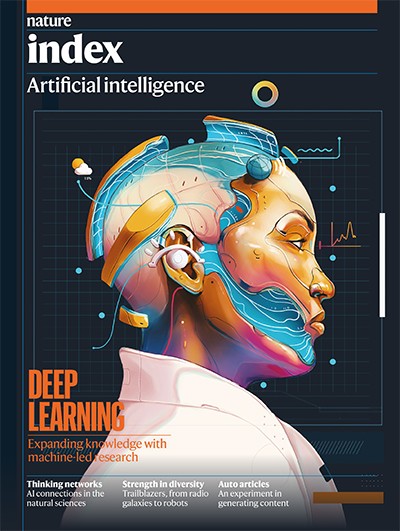The Nature Index is a database of author affiliations and institutional relationships. The index tracks contributions to research articles published in 82 high-quality natural-science journals, chosen by an independent group of researchers.
The Nature Index provides absolute and fractional counts of article publication at the institutional and national level and, as such, is an indicator of global high-quality research output and collaboration. Data in the Nature Index are updated regularly, with the most recent 12 months made available under a Creative Commons licence at natureindex.com. The database is compiled by Nature Research.
Nature Index metrics
The Nature Index uses Count and Share to track research output. A country/territory or an institution is given a Count of 1 for each article that has at least one author from that country/territory or institution. This is the case regardless of the number of authors an article has, and it means that the same article can contribute to the Count of multiple countries/territories or institutions.
To glean a country’s, a territory’s or an institution’s contribution to an article, and to ensure they are not counted more than once, the Nature Index uses Share, a fractional count which takes into account the share of authorship on each article. The total Share available per article is 1, which is shared among all authors under the assumption that each contributed equally. For instance, an article with 10 authors means that each author receives a Share of 0.1. For authors who are affiliated with more than one institution, the author’s Share is then split equally between each institution. The total Share for an institution is calculated by summing the Share for individual affiliated authors. The process is similar for countries/territories, although complicated by the fact that some institutions have overseas labs that will be counted towards host country/territory totals.
The bilateral collaboration score (CS) between two institutions A+B is the sum of each of their Shares on the papers to which both have contributed. A bilateral collaboration can be between any two institutions or countries/territories co-authoring at least one article in the journals tracked by the Nature Index.
NATUREINDEX.COM
natureindex.com users can search for specific institutions or countries and generate their own reports, ordered by Count or Share.
Each query will return a profile page that lists the country or institution’s recent outputs, from which it is possible to drill down for more information. Articles can be displayed by journal, and then by article. Research outputs are organized by subject area. The pages list the institution or country/territory’s top collaborators, as well as its relationship with other organizations. Users can track an institution’s performance over time, create their own indexes and export table data.
This supplement
Nature Index 2020 Artificial intelligence is based on both the Nature Index database and the Dimensions database from Digital Science, covering the Nature Index articles published between 1 January 2015 and 31 December 2019 as well as the Dimensions publications during the same period. Both keyword search and fields of research search have been used to extract artificial-intelligence publications in Dimensions, including journal and conference papers. Artificial-intelligence articles in the Nature Index are those extracted publications that are also in the Nature Index database.
Nature Index 2020 Artificial intelligence
The following keywords have been searched in the Dimensions database: ‘machine learning’, ‘artificial intelligence’, ‘machine intelligence’, ‘machine vision’, ‘supervised learning’, ‘unsupervised learning’, ‘deep learning’, ‘reinforcement learning’, ‘transfer learning’, ‘Bayesian learning’, ‘ensemble learning’, ‘federated learning’, ‘generative adversarial network’, ‘random forest’, ‘support vector machine’, ‘explainable AI’, ‘computer vision’, ‘speech recognition’, ‘face recognition’, ‘natural language processing’, ‘autonomous vehicle’, ‘driverless car’, ‘self-driving car’, ‘DeepVariant’, ‘Clairvoyante’, ‘WhatsHap’, ‘statistical learning theory’, ‘sentiment analysis’, ‘emotion AI’, ‘opinion mining’, ‘neurocomputing’, ‘neural computing’, ‘neurocomputation’, ‘neural computation’, ‘neural fuzzy network’ and ‘neural network’.
When searching among neuroscience publications where the keyword ‘neural network’ tends to pick up publications that are not related to artificial intelligence, we have replace the general term ‘neural network’ with the following specific neural network terms, ‘artificial neural network’, ‘Bayesian neural network’, ‘multilayer neural network’, ‘distributed neural network’, ‘convolutional neural network’, ‘computational neural network’, ‘deep neural network’, ‘deeper neural network’, ‘fuzzy neural network’, ‘neural network model’, ‘spiking neural network’ and ‘unsupervised neural network’.
It’s estimated that less than 2% of the extracted publications are false positive results that are not related to artificial intelligence, and another 6% are only weakly related, based on a manual check of a random sample of extracted papers.
The tables in this supplement show the top institutions, top countries/territories in artificial intelligence based on their total output between 2015 and 2019, and the top rising institutions in the field based on change in their output from 2015 to 2019 in both the Nature Index and Dimensions databases. Nature Index output is measured by article share (Share), and Dimensions output is measured by the number of publications. There are also more top institution tables by institution sector based on the Nature Index data on natureindex.com.

 Artificial-intelligence research escalates amid calls for caution
Artificial-intelligence research escalates amid calls for caution
 The race to the top among the world’s leaders in artificial intelligence
The race to the top among the world’s leaders in artificial intelligence
 Network effect: Visualizing AI connections in the natural sciences
Network effect: Visualizing AI connections in the natural sciences
 Six researchers who are shaping the future of artificial intelligence
Six researchers who are shaping the future of artificial intelligence
 AI will change the world, so it’s time to change AI
AI will change the world, so it’s time to change AI
 Four AI technologies that could transform the way we live and work
Four AI technologies that could transform the way we live and work
 Samsung’s head researcher wants human–AI interactions to be a multisensory experience
Samsung’s head researcher wants human–AI interactions to be a multisensory experience
 Sliced, diced and digested: AI-generated science ready in minutes
Sliced, diced and digested: AI-generated science ready in minutes
 Auto articles: An experiment in AI-generated content
Auto articles: An experiment in AI-generated content


